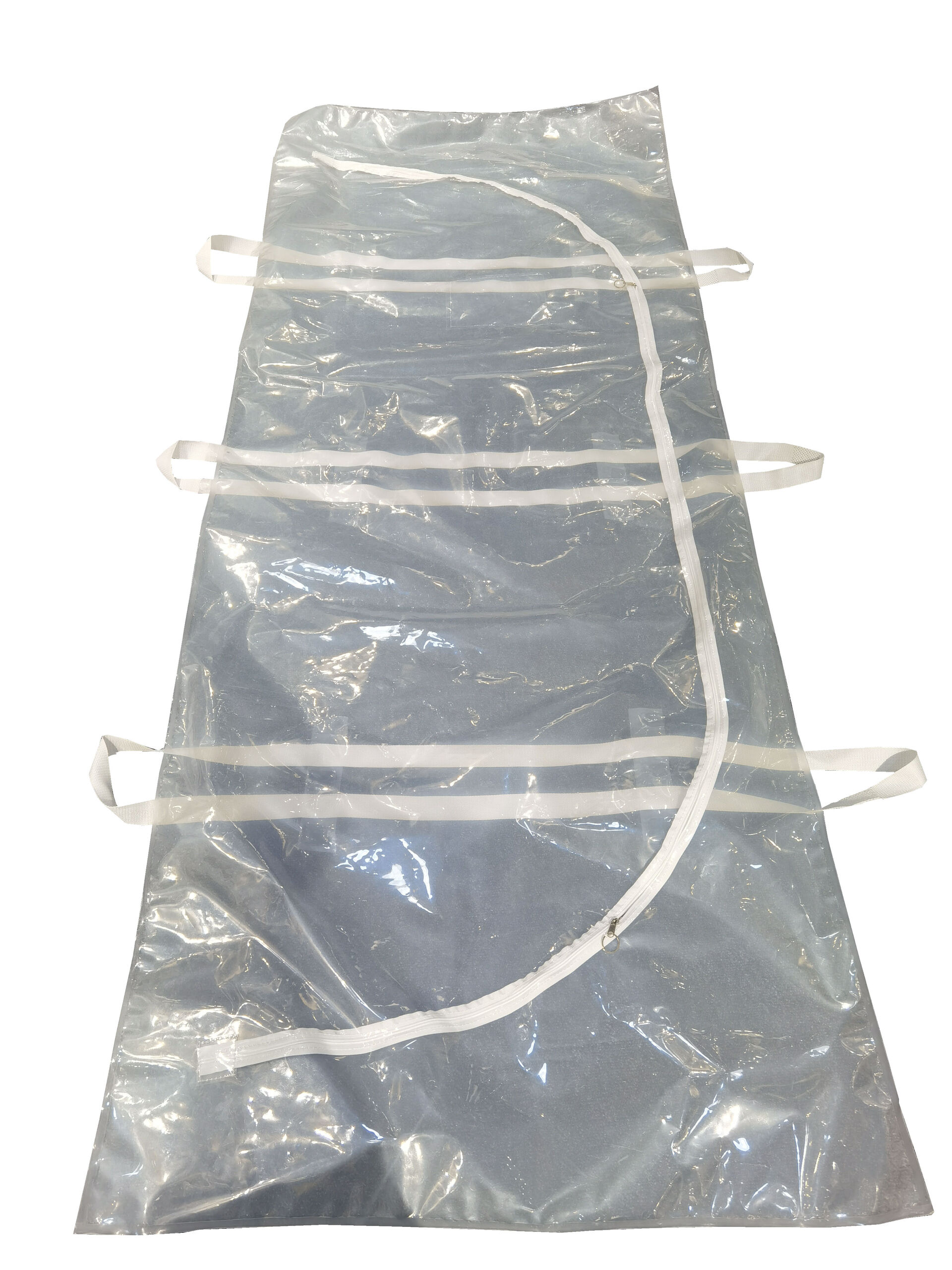
Product center
Emergency Transparent PVC Body Bag is made of high-quality, transparent PVC material that provides a clear view of the body inside. This allows for easy identification of the individual and can help prevent any potential mix-ups or confusion. The PVC material is also strong and durable, with a high resistance to punctures and tears, ensuring the bag can safely hold the weight of the body and protect it from any outside elements.
The bag is designed with a three-sided, double zipper closure that provides a secure and airtight seal to prevent any leakage or contamination. The zipper is easy to use and allows for quick access to the body when needed. Additionally, the bag has six reinforced handles for easy handling and transportation, even with the added weight of the body.
One of the key benefits of the Emergency Transparent PVC Body Bag is its versatility. It can be used in a variety of situations, including natural disasters, pandemics, and mass casualty incidents. It is also suitable for long-term storage in a morgue or other facility, as it offers protection from moisture, dust, and pests.
Another important aspect of the Emergency Transparent PVC Body Bag is its ease of use. It can be quickly and easily opened, allowing for rapid transfer of the body from the scene to the appropriate location. The bag is also lightweight and compact, making it easy to store and transport in emergency response vehicles and medical facilities.
Emergency Transparent PVC Body Bag is an essential tool for emergency responders, medical professionals, and morgue personnel. Its transparent material, sturdy construction, and easy-to-use design make it a reliable choice for transporting and storing human remains during emergency situations.
Material: PVC,PEVA, Plastic, Nonwoven or custom
Size: 246x90 CM or custom
Color: orange, blue black or white or customed
Certification: ISO9001, SGS, If you Need original certificets, pls contact me
Packing: 1 Piece /poly Bag ,Moderate amount into the carton
RFQ
Cadaver bags, also known as body bags, are essential tools used to transport deceased individuals. These bags are made of durable and sturdy materials, such as PVC or polyethylene, to ensure that they can securely hold the weight of a deceased person and protect them from outside elements.
One of the main reasons we need to use cadaver bags is for hygiene purposes. When someone passes away, their body will start to decompose, which can lead to the spread of harmful bacteria and diseases. By placing the body in a cadaver bag, we can minimize the risk of infection and ensure that the body is properly contained.
Cadaver bags also help to maintain the dignity of the deceased. When a person passes away, it is important that their body is treated with respect and care. By using a cadaver bag, we can ensure that the body is covered and protected, and that the transportation process is handled with the utmost sensitivity and professionalism.
Furthermore, cadaver bags are also important for safety reasons. In situations where the cause of death is unknown or suspicious, it is essential to transport the body in a secure and safe manner to avoid any potential contamination or interference with evidence.
In summary, the use of cadaver bags is vital in ensuring that the deceased are treated with dignity, respect, and safety. They provide a hygienic and secure method of transporting the deceased, which is essential for the safety of those handling the body and for maintaining the integrity of the deceased.
What is the Color of Dead Body Bag
The color of a dead body bag is often a subject of curiosity and speculation. Dead body bags come in a variety of colors, depending on their purpose and the location where they are used.
One of the most commonly used colors for dead body bags is black. Black body bags are used in many countries and are often associated with death and mourning. They are often used in funeral homes and mortuaries to transport the deceased to their final resting place. Black body bags are also used by emergency responders to transport bodies from accident scenes or crime scenes to the coroner's office.
White body bags are also common and are used for similar purposes. White bags are often used in hospitals and nursing homes to transport deceased patients to the morgue. They are also used in forensic investigations and by coroners to transport bodies from crime scenes.
Red body bags are less common and are typically used for disaster response. Red bags are used to transport bodies in mass casualty incidents, such as natural disasters or terrorist attacks. The bright color makes it easier for responders to identify and track the bodies.
In some countries, body bags are also available in other colors, such as blue or green. These colors may be used for cultural or religious reasons, or simply to differentiate between bodies in a mass casualty situation.
In conclusion, the color of a dead body bag can vary depending on its intended use and the cultural or religious practices of the area where it is being used. While black and white are the most common colors, red and other colors may be used in specific situations. Regardless of the color, the purpose of a body bag remains the same: to provide a dignified and respectful means of transporting the deceased to their final resting place.
What the Material of Corpse Bag?
The material used to make a corpse bag, also known as a body bag, is an important consideration in ensuring the safe and dignified transportation of the deceased. The material must be durable enough to handle the weight of the body and any fluids that may leak from it, as well as prevent contamination and the spread of disease.
One of the most commonly used materials for corpse bags is PVC. This material is strong, waterproof, and resistant to tearing, making it ideal for the task. PVC body bags are also available in different thicknesses, allowing for customization based on the weight of the deceased.
Another material used for body bags is PEVA. PEVA body bags are more expensive than PVC body bags, but they are also more durable and can withstand higher temperatures, making them suitable for use in crematoriums.
Nonwoven, oxford, plastic are also used to make body bags, but they are less common due to their absorbent nature and difficulty in cleaning.
In addition to the material used to make the bag, some body bags also feature additional components for added protection and hygiene. For example, some bags may have a zipper closure or Velcro straps to seal the bag and prevent leakage. Others may have handles for easier transportation, or come with an absorbent pad to soak up any fluids.
In conclusion, the material used to make a corpse bag is an important consideration in ensuring the safe and dignified transportation of the deceased. Polyethylene and vinyl are the most common materials used, with additional components for added protection and hygiene. Ultimately, the material chosen will depend on factors such as the weight of the deceased, the location of the transportation, and the preferences of the funeral home or coroner's office.
What the Type of Dead Body Bag?
Dead body bags, also known as body bags or cadaver bags, come in different types to accommodate different situations and transportation needs. The type of body bag chosen depends on the situation, the location, and the preferences of the funeral home or coroner's office.
The most common type of body bag is the standard adult body bag. These bags are made from strong, waterproof materials and are designed to handle the weight of an adult body. They may feature a zipper closure or Velcro straps to seal the bag and prevent leakage, as well as handles for easier transportation.
Infant body bags are also available, designed specifically for the transportation of deceased infants. These bags are smaller in size and made from softer, more delicate materials to ensure the safe and dignified transportation of the deceased infant.
In addition, body bags are available for transporting larger bodies or those with special needs. Bariatric body bags, for example, are designed for the transportation of larger individuals, while disaster body bags are used in mass casualty situations.
Another type of body bag is the biohazard bag. These bags are used in situations where the deceased may pose a risk of contamination or infection. Biohazard bags are made from materials that can withstand high temperatures, ensuring proper disinfection and sterilization.
Finally, there are specialized body bags designed for specific situations, such as underwater recovery bags or body bags with air holes for transportation by air.
In conclusion, there are several types of dead body bags available to accommodate different transportation needs and situations. Standard adult body bags and infant body bags are the most common, but there are also specialized bags for larger individuals, biohazard situations, and specific transportation needs. The choice of bag will depend on the situation and the preferences of the funeral home or coroner's office.
Related to recommend
 PVC Funeral Cadaver Corpse Dead Body Bag
PVC Funeral Cadaver Corpse Dead Body Bag
PVC funeral cadaver corpse dead body bags are available in different sizes and thicknesses, depending on the requirements of the user. They are designed to be leak-proof and have a seamless construction that prevents the spread of bacteria and viruses. The bags are also resistant to tearing and puncturing, which ensures that the remains are not damaged during transportation. PEVA Funeral Cadaver Corpse Dead Body BagPEVA (polyethylene vinyl acetate) is a type of plastic material that is widely used in manufacturing various products, including funeral cadaver corpse dead body bags. PEVA is a more eco-friendly and safer alternative to PVC (polyvinyl chloride) material as it does not contain chlorine or other harmful chemicals.
PEVA Funeral Cadaver Corpse Dead Body BagPEVA (polyethylene vinyl acetate) is a type of plastic material that is widely used in manufacturing various products, including funeral cadaver corpse dead body bags. PEVA is a more eco-friendly and safer alternative to PVC (polyvinyl chloride) material as it does not contain chlorine or other harmful chemicals. HDPE Funeral Cadaver Corpse Dead Body BagHDPE funeral cadaver corpse dead body bags is strength and durability. They are resistant to tears and punctures, ensuring that the remains remain secure and protected during transportation and storage. Additionally, they are waterproof and airtight, providing a barrier against moisture and odors.
HDPE Funeral Cadaver Corpse Dead Body BagHDPE funeral cadaver corpse dead body bags is strength and durability. They are resistant to tears and punctures, ensuring that the remains remain secure and protected during transportation and storage. Additionally, they are waterproof and airtight, providing a barrier against moisture and odors. Adult Funeral Cadaver Corpse Dead Body BagFuneral cadaver corpse dead body bags is polyethylene, which is a type of plastic that is resistant to tears and punctures. This material is also waterproof, which helps to prevent any leakage from the body. These bags also come in a range of sizes, from small to extra-large, to accommodate different body types.
Adult Funeral Cadaver Corpse Dead Body BagFuneral cadaver corpse dead body bags is polyethylene, which is a type of plastic that is resistant to tears and punctures. This material is also waterproof, which helps to prevent any leakage from the body. These bags also come in a range of sizes, from small to extra-large, to accommodate different body types.
Online consulting




